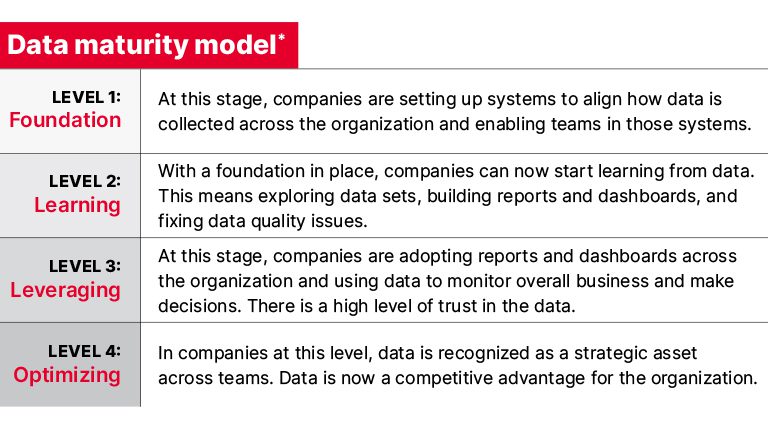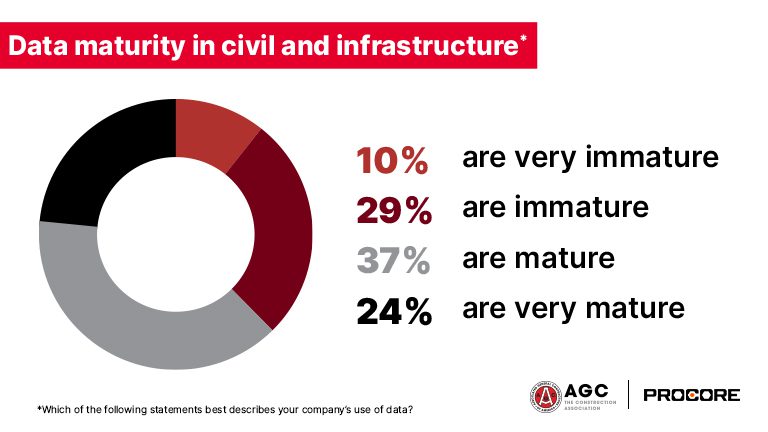Dormant to Dominant: Evolving Role of Data on Civil and Infrastructure Projects

The construction industry has always thrived on data, with builders relying on a multitude of data points to meticulously plan, execute, and successfully complete projects. However, despite this data-rich environment, a significant portion of invaluable data often remains dormant, overlooked, and underutilized.
Astonishingly, a staggering 96% of construction data goes entirely unused, according to an FMI report. This statistic is disheartening, especially in contrast with other industries that consider data as the holy grail, particularly in the realm of risk management.
The true value of data-driven operations shines most brilliantly in the context of civil and infrastructure projects. Given the immense scale, inherent risks, and complex operational nature of these projects, the ability of heavy civil and infrastructure builders to harness the full potential of their data becomes not just beneficial, but imperative.
This leads us to a compelling question: How can you determine if you’re truly optimizing your data’s potential? And what does the entire journey toward achieving a more data-driven approach entail? In this article we delve deep into the concept of data maturity as it pertains to civil and infrastructure builders and also uncover how it influences projects and shapes outcomes.
Understanding data maturity
Data maturity, in essence, is the measure of an organization’s capability to effectively manage, utilize, and derive value from its data assets. At Procore we like to think of it as a progressive journey that reflects an organization’s evolving relationship with data, spanning from the basic collection of data to its transformation into a strategic asset.
And we aren’t alone in believing so.
The process of digitizing and standardizing data significantly enhances its value, unlocking limitless potential for innovation.”
– Morgan Field, Project Engineer at Aetna Bridge Company
The data maturity framework consists of four levels or stages, each building upon the previous one, and it serves as a roadmap for organizations to enhance their data-related capabilities. As organizations progress through these stages, they not only become more adept at handling data but also better equipped to leverage it as a competitive advantage and a catalyst for informed decision-making.
The graphic below highlights these stages along with attributes related to data use at each juncture.

Data maturity within civil and infrastructure
A recent research report conducted by AGC and Procore highlights the significant room for improvement when it comes to data maturity within civil and infrastructure construction.

Alarmingly, just 24% of respondents believe they are harnessing the full potential of their data as a key business differentiator. A majority of respondents (66%) find themselves at the learning or leveraging stage (Level 2 or 3) of the data maturity framework, signifying that they are still in the midst of their data maturity journey.
These findings underscore the pressing need for civil and infrastructure builders to embark on a transformative journey towards enhancing their data maturity, ultimately harnessing the power of data as a competitive edge and a catalyst for success in the industry.
Impact of data maturity on civil and infrastructure projects
Data in general, holds immense value on civil and infrastructure builds since these are often massive, complex and long-lasting projects. Structures like bridges, tunnels and dams require precise planning and execution. This high level of complexity and build environment uncertainty increases overall project risk, both for owners and contractors. Data often serves as a crucial counterbalance for managing these risks. When you add in the various regulatory compliance and permitting workflows associated with these projects, the value of data cannot be emphasized enough.
The journey towards data maturity is far from an abstract concept for civil and infrastructure builders; it’s a transformative process that reverberates throughout their entire operation.
The downstream operational impact of data maturity is unmistakably evident in the report, shaping the very essence of how these contractors conduct their business.
One striking revelation is the correlation between the number of delivery methods a contractor employs and their level of data maturity. For instance, those who have achieved optimized data maturity find themselves engaged with an average of 3.4 delivery methods, whereas firms at a foundational data maturity level report involvement in only 2.3. The significance of this correlation is profound — more data-mature organizations are inherently more likely to harness a diverse array of delivery methods. This virtuous cycle perpetuates itself as these methods, in turn, elevate data maturity even further.

But perhaps the most compelling outcome of advancing data maturity is its positive correlation with the achievement of project goals. Across the spectrum of project goals, including quality, safety, budget, schedule, and profitability, data maturity emerges as a guiding light. Civil and infrastructure builders with more sophisticated data collection, management, and usage capabilities are demonstrably better equipped to deliver positive outcomes on their projects. This correlation underscores the pivotal role data plays in ensuring that civil and infrastructure projects not only meet but often surpass their goals.
Embarking on a journey towards data maturity
The path to enhancing data maturity starts by gaining a comprehensive understanding of your organization’s current position. This fundamental step involves addressing a set of key challenges. To start with, it entails exploring avenues for enhancing data collection and acquisition. Subsequently, streamlining data storage and management processes becomes imperative. Thirdly, there’s the need to elevate data analysis and interpretation capabilities. Lastly, fostering a culture deeply rooted in data-centricity and innovative ways of operating becomes a pivotal goal.
Centralizing data and having all the data at your fingertips really helps you do a better job of understanding where you need to be paying attention.”
– Chris Wright, EVP of Operations Support at Nabholz
What becomes abundantly clear is that achieving significant progress in data maturity hinges on orchestrating a harmonious blend of strategic actions and activities across the realms of people, processes, and technology.



